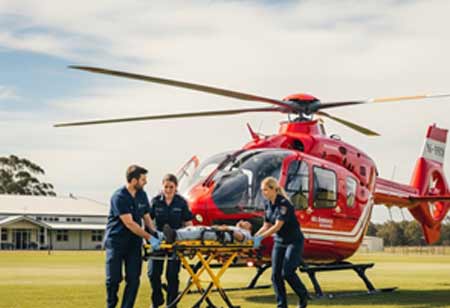Thank you for Subscribing to Healthcare Business Review Weekly Brief
Be first to read the latest tech news, Industry Leader's Insights, and CIO interviews of medium and large enterprises exclusively from Healthcare Business Review
Saving Lives at Altitude: Air Care Advancements
Air ambulance services evolve with ICU-level care, specialized support, and innovative technologies, leading to faster, safer, and more responsive medical transport.

By
Healthcare Business Review | Tuesday, June 24, 2025
Stay ahead of the industry with exclusive feature stories on the top companies, expert insights and the latest news delivered straight to your inbox. Subscribe today.
Fremont, CA: Air ambulance services are undergoing significant advancements, integrating essential medical care with state-of-the-art aviation practices. These airborne intensive care units are now equipped to accommodate a diverse patient population, ranging from newborns to elderly individuals, and facilitate transportation over extensive global distances. Recent innovations in technology and operational systems have markedly enhanced safety, efficiency, and the overall quality of care provided during medical transport, representing a new standard in this critical field.
Expanding Scope of Patient Care in the Air
Medical transport today is no longer about simply flying patients from one location to another. The focus is shifting toward providing advanced, in-flight medical care tailored to individual needs. Air ambulances are now equipped with ICU-grade equipment, enabling the management of ventilators, infusion pumps, cardiac monitors, and other life-support systems during flight. Medical crews on board are highly trained in emergency and critical care, capable of delivering complex interventions even in mid-air conditions.
There is a growing emphasis on serving patients with specific care requirements. Neonatal and pediatric transfers now often involve customized incubators, specialized monitoring tools, and trained staff who understand the unique needs of young patients. Aging populations and an expansion in chronic illnesses have led to more requests for transfers of elderly patients who require continuous care during long-distance travel. These missions are carefully planned to ensure safety, stability, and comfort throughout the journey.
Medical tourism is another factor influencing the expansion of services. Patients seeking treatment abroad often require post-operative transport or emergency repatriation. Air ambulances have adapted by offering multilingual crews, standardized protocols across borders, and the ability to liaise effectively with hospitals in multiple countries. The ability to deliver care across vast distances without interrupting treatment has become a key feature of modern air medical services.
Technology and Systems Optimizing Response
Behind the scenes, technology is pivotal in transforming the speed and coordination of air ambulance operations. GPS and satellite-based navigation systems have greatly improved route planning, especially when weather, terrain, or airspace restrictions could otherwise cause delays. These tools also support night flights and emergency landings with greater safety and efficiency.
Telemedicine is becoming an essential part of airborne care. Flight crews can consult with specialists on the ground through real-time audio and video communication, receive advice on treatment adjustments, and access diagnostic support. This helps ensure that the care provided in the air aligns with hospital standards, especially during long or complex transfers.
Data integration is helping crews make more informed decisions. Patient records can now be securely shared before takeoff, giving the onboard team a complete picture of the individual’s medical history, current medications, and existing conditions. This seamless access to information minimizes errors and enhances coordination with the receiving facility upon landing. The industry is also exploring sustainable solutions to address environmental concerns. Reducing emissions include investing in lighter aircraft, alternative fuels, and more efficient flight planning.






